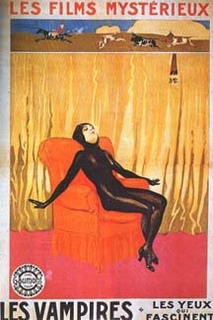I’d have to say upfront that the female stunt performers at the very start of the film industry were very impressive. They were always expected to do things that even men wouldn’t do. I’m sure that hasn’t changed over the years because just a few years ago, acclaimed stuntman and Arnold Schwarzegenner Stunt Double, Peter Kent, said of female stunt performers, “A lot of times the guys are wearing pads and stuff under their pants. But then you’ll get a woman in a skimpy dress doing a stair fall, and you can’t hide anything under that. I give kudos to a lot of the stunt-women out there because many times they take way more of a beating than the men do. ‘We want you to do this in a frigging negligee. Okay.'”
Musidora gets my nod for 1915 due to sheer style. Her mystique was accentuated by large, dark eyes and a habit of wearing a black leotard, hood and tights while on the set. Born Jeanne Roques, she used Musidora as a stage name. She started out as an acrobat and did all her own stunts in this film serial. It’s also interesting to note, her character’s name in the film, Irma Vep, is an anagram for Vampire. Vamp is a colloquial term applied to describe a particular type of femme fatale, popular in silent films. The term is a shortening of the word vampire, and is used to describe a woman who is glamorous in an exotic, stylized and usually overstated manner. She is usually noted for her striking features, dark clothing and hair, and cosmetics which darken and accentuate the eyes and lips. Her character is a heartless seductress, and the men she seduces are usually shown as helpless victims unable to resist her. From the perspective of American film audiences, she is often seen as foreign, usually of undetermined Eastern European or Asian ancestry. She was designed as the sexual counterpoint of the wholesome actresses such as Lillian Gish and Mary Pickford. Among the notable vamps of the silent screen were Theda Bara, Louise Glaum, Musidora, Nita Naldi, Pola Negri, and in her earliest film appearances, Myrna Loy.
The Gaumont film, Les Vampires, directed by French film Director, Louis Feuillade, is a 10-part serial, and is about gangsters and secret societies inspired by the exploits of the real-life Bonnot Gang, rather than what the title suggests, Vampires. It’s a very good film serial and is very popular for it’s many twists throughout the film. It’s considered one of the first action crime thrillers. Though not intended to be “avant-garde,” Les Vampires has been lauded by critics as the birth of avant-garde cinema and cited by such renowned filmmakers as Fritz Lang and Luis Buñuel as being extremely influential in their desire to become directors. It’s listed in “1001 Movies You Must See Before You Die” edited by Steven Jay Schneider.
Things to look up (go to IMDB):
Glossary of film terms as defined by Wikipedia:
- Femme-Fatale – The phrase is French for “deadly woman”, a mysterious and seductive woman whose charms ensnare her lovers in bonds of irresistible desire, often leading them into compromising, dangerous, and deadly situations. She is an archetype of literature and art. Her ability to entrance and hypnotize her victim with a spell was in the earliest stories seen as being literally supernatural; the femme fatale today is still often described as having a power akin to an enchantress, seductress, vampire, witch, or demon, having some power over men.
A femme fatale tries to achieve her hidden purpose by using feminine wiles such as beauty, charm, and sexual allure. In some situations, she uses lying or coercion rather than charm.
Although typically villainous, if not morally ambiguous, and always associated with a sense of mystification and unease, femmes fatales have also appeared as antiheroines in some stories, and some even repent and become true heroines by the end of the tale.
- Avant-Garde – Avant-garde(from French, “advance guard” or “vanguard”) is a French term used in English as a noun or adjective to refer to people or works that are experimental or innovative, particularly with respect to art,culture, and politics.
Avant-garde represents a pushing of the boundaries of what is accepted as the norm or the status quo, primarily in the cultural realm. The notion of the existence of the avant-garde is considered by some to be a hallmark of modernism, as distinct from postmodernism.
Check out our new Book, 100 Years of the Best Movie Stunts!


